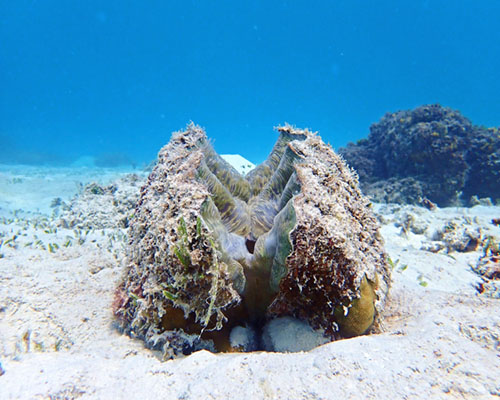
Hippopus hippopus, commonly known as the giant clam or bear paw clam, is a species of large, heavy-shelled clam belonging to the Tridacnidae family.
Here are some key characteristics and information about Hippopus hippopus:
- Size: Hippopus hippopus is one of the larger species of giant clams. It can reach sizes of up to 24 inches (60 cm) or more.
- Shell: The shell of Hippopus hippopus is thick and heavy, with a distinctive shape. The exterior is often covered in a rough periostracum, which can be brown, green, or a combination of colors. The shell may also have prominent folds and ridges.
- Mantle: The mantle of the clam is responsible for its characteristic appearance. It can be various shades of blue, green, brown, or even purple. The mantle is also responsible for the clam’s iridescence, making it visually striking.
- Symbiotic Relationship: Similar to other giant clams, Hippopus hippopus forms a symbiotic relationship with photosynthetic zooxanthellae, which are algae living in the clam’s tissues. These algae contribute to the clam’s nutrition through photosynthesis.
- Habitat: Hippopus hippopus is typically found in shallow, tropical reef environments, especially in areas with clear and well-illuminated waters. They are sessile, attaching themselves to hard substrates like rocks or coral.
- Feeding: As a filter feeder, Hippopus hippopus filters small particles from the water, including plankton and organic debris. It obtains additional nutrients through its symbiotic relationship with zooxanthellae.
- Conservation: Like other giant clam species, Hippopus hippopus is vulnerable to overharvesting and habitat destruction. Conservation measures are in place to protect giant clams, and trade is regulated to prevent their decline.
Here is more detailed information about Hippopus hippopus:
- Physical Characteristics:
- Size: Hippopus hippopus is among the largest species of giant clams, with shells that can reach sizes exceeding 24 inches (60 cm) in length.
- Shell: The shell of Hippopus hippopus is thick and heavy, exhibiting a unique shape with prominent folds and ridges. The color can vary but is often brown, green, or a combination of colors. The exterior may be covered with a rough periostracum.
- Mantle: The mantle is the fleshy part of the clam that extends beyond the shell. It is known for its vibrant and diverse colors, including shades of blue, green, brown, and purple. The mantle is responsible for the clam’s striking appearance.
- Habitat and Distribution:
- Natural Habitat: Bear paw clams are typically found in shallow, tropical reef environments, particularly in areas with clear and well-illuminated waters. They attach themselves to hard substrates like rocks or coral.
- Geographic Range: Their native range includes the Indo-Pacific region, encompassing areas such as the Philippines, Indonesia, and Papua New Guinea.
- Symbiotic Relationship:
- Like other giant clams, Hippopus hippopus engages in a symbiotic relationship with photosynthetic zooxanthellae. These algae live within the clam’s tissues and provide it with nutrients through photosynthesis. In return, the clam offers protection and a nutrient-rich environment for the algae.
- Feeding:
- Bear paw clams are filter feeders, actively drawing in water and filtering out plankton and organic particles to obtain nutrients. Their diet is supplemented by the products of photosynthesis from the zooxanthellae.
- Conservation Status and Threats:
- Giant clams, including Hippopus hippopus, face threats such as overharvesting for the aquarium trade and habitat destruction. Conservation efforts are in place to protect these species, and regulations govern their trade to prevent overexploitation.
- Aquarium Considerations:
- Keeping bear paw clams in a marine aquarium requires careful attention to lighting, water quality, and suitable tank conditions. Due to their large size and specific care needs, they are often recommended for experienced marine aquarists.

